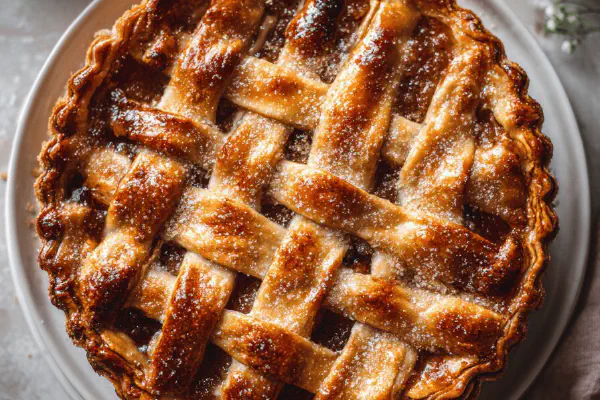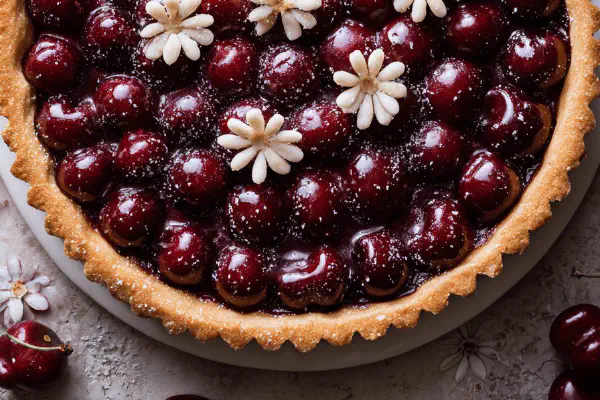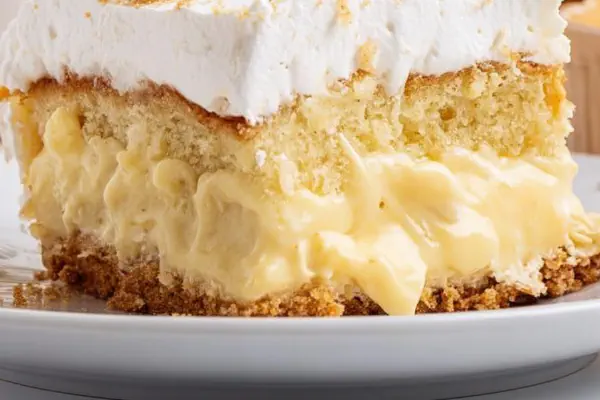Maple Lattice Tart Twist

By Emma
Certified Culinary Professional
Ingredients
- 160 ml (2/3 cup) maple syrup
- 160 ml (2/3 cup) whipping cream 35%
- 25 ml (1 1/2 tbsp) tapioca starch
- 20 ml (1 1/3 tbsp) coconut oil
- 1 sheet 220 g puff pastry, thawed
- 1 egg yolk
- 20 ml (1 1/3 tbsp) water
- smoked maple sugar for sprinkling, optional
About the ingredients
Method
- Start with cold pan off heat. Whisk maple syrup, cream, and tapioca starch until smooth. Toss in coconut oil chunks. Move to low-medium heat. Stir constantly; bubbles signal nearing boil — watch it don’t scorch. Once boiling, simmer 20 seconds, thickening into creamy custard. It should coat the spoon, heavy and smooth. Pour in bowl; press plastic wrap directly onto surface to prevent skin. Cool completely in fridge — this step’s non-negotiable for texture.
- Position oven rack low. Preheat at 210°C (410°F), hotter than usual to give puff that golden blast.
- Flour board lightly. Roll pastry out 27 cm square. Cut into two equal rectangles. Place on lined baking tray, cover loosely with clean towel, chill 25-30 minutes. Resting stops shrinkage and helps pastry stay crisp during cooking.
- Mix egg yolk with water. This wash gives shine; don’t skip.
- On floured board, slice one pastry rectangle into 12 long strips with a pizza cutter or sharp knife. Keep scraps.
- Moisten border of second rectangle with water (not too wet, a dab then calm). Arrange 3 strips around edge to form a rim; acts like dam for filling—crucial to prevent soggy mess. Fill center evenly with chilled maple cream. Moisten rim again. Lay 5 strips diagonally, spaced evenly, pressing edges gently but firmly onto border. Wet edges again. Weave another 5 strips in opposite diagonal direction, creating a lattice. Reuse dough scraps for extra strips to fill gaps or fix edges if needed.
- Trim edges clean with sharp knife for neatness. Brush entire top with egg wash — boosts color and seals lattice. Sprinkle lightly with smoked maple sugar for a touch of smoky caramel crunch, optional but worth it.
- Bake 30-38 minutes. Watch that puff—the pastry should rise sharply, edges golden brown with little blister bubbles. The lattice darkens slightly, crisp and crackly. Avoid over-baking or filling will dry out and crust can burn.
- Remove, let cool 15 minutes on rack. Warm but not hot best; filling sets but stays silky, pastry crisp but tender. Store leftovers wrapped in fridge but serve near room temp to revive crispness.
Cooking tips
Chef's notes
- 💡 Start whisking cold off heat. Maple syrup, cream, tapioca starch combined first. No lumps. Adding coconut oil chunks right here seals texture later. On stove low-medium, stir constantly. Listen for soft bubbling. Don’t walk away. Near boiling means cream thickens fast then hold it. Too hot scorches flavor; not hot enough stays runny. Custard coats spoon heavy and smooth? Perfect stage to stop.
- 💡 Pressing plastic wrap directly on custard surface. Skip air gaps, skin forms fast otherwise. Fridge chill mandatory—filling firms, easier to handle. I’ve lost batches skipping cooling. Texture noticeable; filling silky, no surface wrinkle. Cream texture improves with this step. Don’t rush; patience pays here.
- 💡 Pastry cutting is key. Roll out 27 cm square on floured board. Chill before weaving. Cold dough essential to keep layers flaky, avoid stickiness. Use pizza cutter for even strips. Water dab on edges acts like glue. Too wet = chewy borders; too dry = leaks. Balance needed. Weaving lattice diagonally supports structure better than criss-cross; gives better oven spring and crisp contrast.
- 💡 Egg wash is more than shine. Mixed with water dries faster than milk version but less color. Brush evenly, don’t soak pastry. Watch edges baking for first signs of burn; adjust oven rack or heat if needed. Oven at 210°C hot and rack low pushes puff pastry magic puff and caramelized color quickly. Missing these causes flat or pale crust.
- 💡 Smoked maple sugar optional but adds distinct crunch and aroma. Substitute with raw sugar + pinch smoked paprika if unavailable. Sprinkle lightly; too much burns. Watch closely through baking toward end. Cooling 15 minutes is crucial. Filling sets just right; pastry stays crisp but not hardened. Refrigerate leftovers wrapped; warm before serving to bring back texture contrast.
Common questions
Why tapioca starch over cornstarch?
Tapioca gives translucent, silkier cream. Cornstarch can make cloudy or gummy if overcooked. Tapioca needs constant stir, watch thickening carefully. Texture difference noticeable after chilling. I flipped back and forth but tapioca wins for clarity and feel.
Can I use butter instead of coconut oil?
Butter okay but coconut oil resists heat better. Butter risks burning; coconut adds gentle nutty aroma without overpowering. If you prefer butter, use refined and watch cooking temp lower. Oils vary in flash point; coconut better near boiling custard.
Filling forms skin despite plastic wrap?
Plastic wrap must touch surface, no air gaps. Wrap not tight enough or chilled too warm can cause skin. If happens often, double wrap or press wrap anew mid-chill. You can also stir custard occasionally during cool to break film. Not ideal but helps.
How to store leftovers without losing crispness?
Wrap tightly, fridge storage only. Pastry absorbs fridge moisture over time; reheat in oven briefly at moderate temp restores crisp. Microwave kills texture. Room temperature serving better than cold. Use within 2 days; longer wetter and tougher. Freeze not advised due to lattice fragility.



